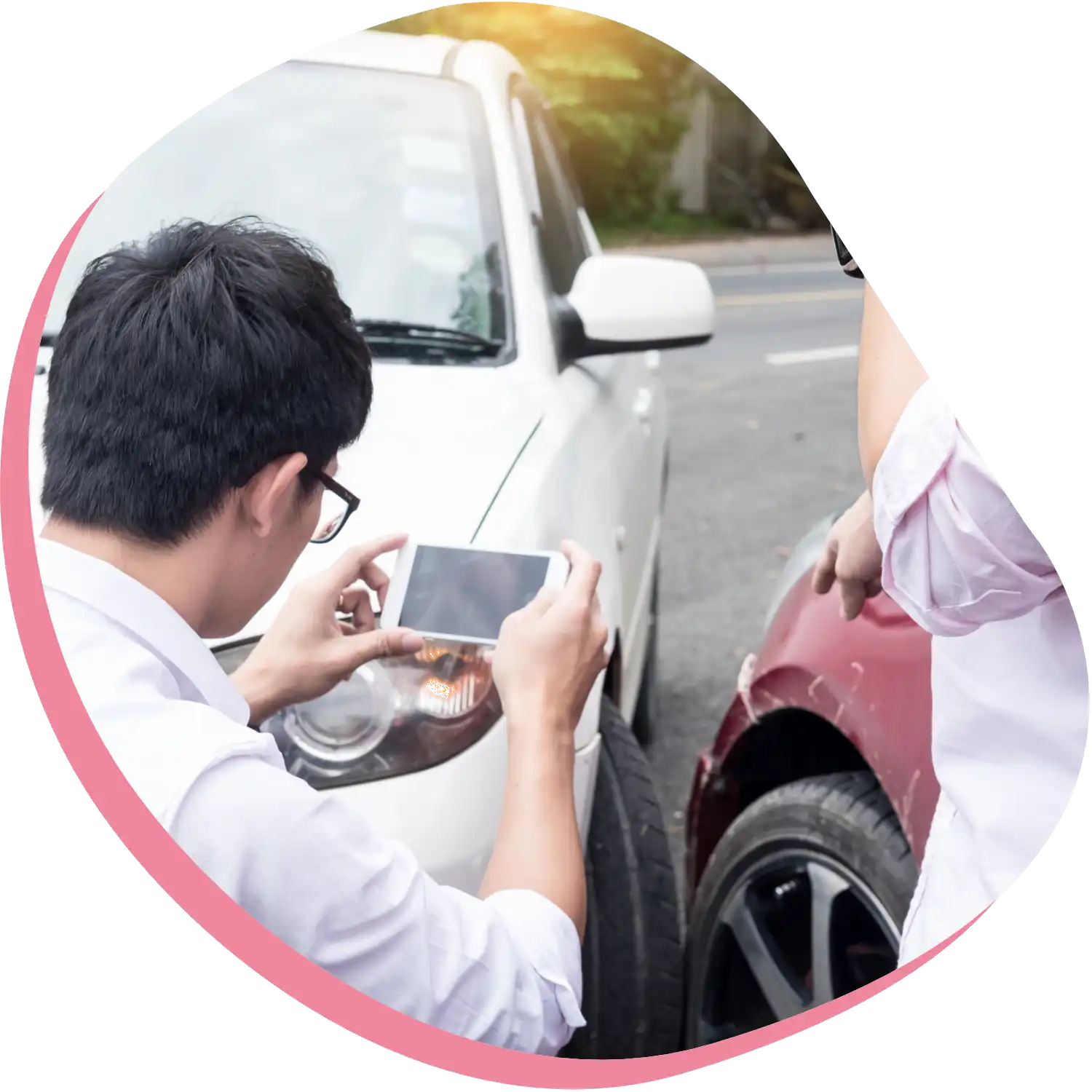What Evidence Do You Need to Pursue a Car Accident Lawsuit?
Learn more about what information you need to gather after an accident to prove your case.




What Evidence Do You Need to Pursue a Car Accident Lawsuit?
Car accidents in the United States injure 2.5 million people. Personal injury laws give you the right to recover compensation, but you need evidence to prove that another driver was at fault in causing the crash.
Getting the evidence needed to prove a car accident claim takes work, but it’s worth the effort. This article explains how to identify and gather the evidence you’ll need to prove how the accident occurred and the losses you suffered.
Apply NowKey Takeaways
- Proving a car accident claim depends on evidence.
- The party suing to recover damages in a car accident case has the burden of proof.
- Evidence car accident attorneys use to prove personal injury claims includes medical bills, police reports, witness statements, photos, videos, and medical bills and records.
Get up to $500,000 with rates as low as 2.5% simple, monthly
Types of Evidence For a Car Accident Lawsuit
Your car accident lawyer needs evidence to prove what caused a car accident and the damages or losses you incurred. The amount and strength of the evidence also influence decisions by the insurance company for the at-fault driver.
Insurance adjusters are more likely to offer a car accident settlement on an insurance claim where the personal injury lawyer for the accident victim has evidence proving fault and damages. If you need money to help pay medical bills, lawsuit funding companies evaluate the evidence to determine whether to approve a lawsuit loan.
The type of evidence depends on the facts that need to be proven. However, police reports, witness statements, photographs and videos, and medical bills and records are the evidence typically used in car accident lawsuits.
Police Reports
A written police report is prepared whenever law enforcement officers respond to an accident scene. It is a public record on file with the motor vehicle department in the state where the accident took place.
Police accident reports contain a great deal of information compiled by law enforcement, making them essential as evidence in the lawsuit and also handy as a guide for your personal injury attorney for gathering evidence about the car crash. Useful information found in police accident reports includes the following:
- Date and time of the accident.
- Location of the accident scene.
- Names and contact information of all drivers and passengers of vehicles involved in the crash.
- License and insurance information of all drivers.
- Names and contact information, including phone numbers of witnesses.
- Police reports may include statements that drivers, passengers, and witnesses gave to law enforcement officers at the accident scene.
- Name, badge number, and police agency of the officers responding to the accident scene.
- Diagram drawn by a police officer showing the position of each of the cars and any damage the officer observed.
- Name of fire departments and ambulance services responding to the accident scene.
- Police reports may include the names of fire departments and ambulance services rendering aid to anyone injured in the accident.
- Name and contact information of anyone given medical treatment at the scene and whether they were transported by ambulance to a hospital.
The contents of a police report help the lawyer handling your personal injury claim to identify witnesses and other sources of evidence needed to prove your claim against the at-fault driver.
Police accident reports are public records obtainable from the law enforcement agency that prepared them or from the motor vehicles department of the state where the accident occurred.
Witness Statements
Getting a witness statement can be crucial to the success of a personal injury claim. Generally, your car accident lawyer cannot use a written witness statement when the person who gave it can testify at trial.
However, getting a witness to give a statement shortly after the date of an accident can prove beneficial to your claim under the following circumstances:
- Refresh a witness’s recollection of prior events: Memories fade over time, so a witness called to testify at trial months or even years after an accident may not recall critical facts that could help your personal injury lawsuit. Witnesses refresh their recollections at trial by looking at written statements previously given by them.
- Impeaching a witness: If the testimony of a witness is inconsistent with statements they previously made, your lawyer may use a written witness statement to challenge them.
- Persuade an insurance company to settle: A witness statement supporting your version of the cause of a crash may persuade an insurance adjuster to offer a settlement rather than risk a substantial jury award by letting the witness testify at the trial.
Your personal injury attorney will arrange to have an investigator contact witnesses and obtain their statements. Lawyers and investigators know how to obtain a person’s cooperation by making them feel at ease and willing to give a statement.
Photographs and Video Evidence
Photographs of the accident scene and your injuries immediately after a collision preserves evidence that will be lost over time. For instance, the position of the vehicles when they come to a stop after a collision could be helpful to prove what caused the accident, but everything changes once tow trucks arrive to take the vehicles away.
Photographs and video document the accident and your physical appearance to use in the case to prove what caused the crash and what your injuries looked like before they began to heal. Take photos from different angles, or ask someone to take them for you of the following:
- Location of all vehicles at the crash site.
- Condition of the exterior of all sides of each vehicle.
- Interior photos of each car to show damage and airbag deployment.
- Road surface, including skid marks, broken glass, and debris within the crash site.
- Road markings painted on the road surface, including lane markings, stop lines, and crosswalks.
- Traffic control devices, such as traffic lights, stop signs, and yield signs.
- Buildings, utility poles, and structures around the crash site.
Security cameras on buildings and traffic cameras on utility poles can be sources for a video showing the accident as it happened. Photographs of the accident scene and videos of the accident can be useful if your attorney hires expert witnesses and accident reconstruction experts.
Ask someone at the scene to take photographs of your injuries. If you cannot take photos of the accident scene, have someone else take them before the vehicles are moved or highway crews remove broken glass and debris.
Medical Records and Bills
If you are injured in a car accident, immediately arrange to be examined by a physician unless emergency medical personnel transport you by ambulance to the emergency department of a hospital. The creation of medical records documenting your injuries and the treatment that you received for them must begin right away.
Medical records are crucial evidence to prove that your injuries resulted from the accident. They also contain notes from the medical providers documenting the nature and extent of your injuries and the treatment administered.
Keep copies of all bills, receipts, and other paperwork that you receive from doctors, hospitals, pharmacies, and other health care providers. Your personal injury attorney needs them to prove the amount of the losses you suffered because of the accident.
When you have a personal injury law firm representing you, your lawyers will obtain medical records and bills from your medical professionals. You can help by signing an authorization for your lawyer to obtain the records.
Organizing and Presenting Evidence
The number of documents and photographs you’ll gather after a car accident can become overwhelming, so organize them before meeting with your attorney. Use individual file folders or an expandable folder with multiple compartments and organize it as follows:
- Police report
- Photographs and video of the accident
- Witness statements
- Medical records
- Medical bills and receipts
Turn the folder or folders over to the law office handling your personal injury claim so lawyers at the law firm can begin working on your case.
Presenting evidence to prove that another party was at fault in causing an accident and the damages that you incurred can be challenging. You may prove that someone was at fault in causing a crash, but you also need to present evidence documenting the damages you suffered. Personal injury attorneys study the law and learn how to present evidence to get their clients a fair settlement.
Get Started
Apply today and get funds as soon as the same day you apply!
Common Challenges in Collecting and Presenting Evidence
Personal injury lawsuits are challenging because the defense attorney and insurance company for the at-fault driver force you to prove fault and damages to succeed through settlement or trial. A common challenge is insufficient evidence.
It’s challenging to achieve a fair settlement when you lack sufficient evidence to prove that another driver caused a collision and that you suffered losses. Unless your lawyer can gather additional evidence, you may be unable to prove your case or convince an insurance company to offer you a fair settlement for your car accident claim.
A common situation in personal injury lawsuits is for an injured person to have only limited evidence. For example, you may have evidence proving that another motorist caused an accident, but you lack the medical evidence to prove the full extent of your injuries. Your lawyer may suggest accepting a lower settlement offer instead of holding out for the most money for your car accident claim.
Another challenge in car accident cases is the rules of evidence. Every state has rules to follow for evidence to be used at trial. For example, testifying about what someone told you is inadmissible in court as hearsay. The rules of evidence require that the person who made the statement be brought to court as a witness to testify.
Most personal injury lawyers offer free consultations where you can learn about the strengths and weaknesses of your case. It’s an excellent way to obtain sound legal advice about what to expect from your car accident lawsuit.